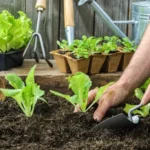If you’re looking to boost your garden’s health naturally you might want to consider using coffee grounds. These everyday kitchen scraps aren’t just waste—they’re a nutrient-rich resource that many plants love. Adding coffee grounds to your soil can improve texture and provide essential nutrients like nitrogen.
But not all plants respond the same way to coffee grounds. Knowing which garden plants thrive with this organic boost can help you get the best results. Whether you grow vegetables flowers or shrubs understanding how coffee grounds affect your garden is a simple way to nurture your plants and reduce waste.
Benefits of Using Coffee Grounds in the Garden
Coffee grounds add value to your garden by supplying vital nutrients and enhancing soil properties. Understanding their nutrient content and impact on soil quality helps maximize these benefits.
Nutrient Content in Coffee Grounds
Coffee grounds contain approximately 2% nitrogen, essential for leafy growth. They also provide small amounts of phosphorus, potassium, magnesium, and trace minerals. You get a natural, slow-release nutrient source that supports plant development without the risk of chemical buildup.
How Coffee Grounds Improve Soil Quality
Coffee grounds improve soil structure by increasing organic matter and promoting microbial activity. They enhance water retention in sandy soils and improve drainage in clay soils. Microorganisms that break down coffee grounds boost nutrient availability, making your soil more fertile and resilient.
What Garden Plants Like Coffee Grounds
Coffee grounds provide nutrients and improve soil conditions, but certain garden plants benefit more from these organic additions. Knowing which plants thrive with coffee grounds helps you apply them effectively and avoid potential harm.
Acid-Loving Plants That Thrive with Coffee Grounds
Coffee grounds slightly acidify the soil, favoring acid-loving plants. You can add coffee grounds around:
- Azaleas
- Blueberries
- Camellias
- Rhododendrons
- Hydrangeas
These plants absorb nutrients better in mildly acidic soil, and coffee grounds enhance their growth and flowering.
Vegetables That Benefit from Coffee Grounds
Certain vegetables respond well to the nitrogen content and organic matter in coffee grounds. You can mix coffee grounds into the soil for:
- Tomatoes
- Carrots
- Spinach
- Peppers
- Beans
These vegetables develop stronger roots and produce higher yields when coffee grounds supplement soil fertility.
Flowering Plants That Respond Well to Coffee Grounds
Many flowering plants thrive with coffee grounds due to improved soil texture and nutrient supply. You can apply grounds near:
- Marigolds
- Petunias
- Geraniums
- Impatiens
- Begonias
These flowers maintain vibrant blooms and better resistance to pests with regular coffee ground application.
How to Use Coffee Grounds in Your Garden
Coffee grounds boost garden health when used correctly. Using them as mulch, compost, or fertilizer enhances soil quality and plant growth without harming your garden.
Applying Coffee Grounds as Mulch
Spread a thin layer, about 1/4 inch, of coffee grounds evenly on the soil surface. Avoid thick layers, as they can compact, block water, and create mold. Mix grounds with leaves, straw, or shredded bark to improve aeration and prevent clumping. Use mulch around acid-loving plants like azaleas and blueberries to maintain soil moisture and deter weeds.
Mixing Coffee Grounds into Compost
Add coffee grounds to your compost pile in moderation, targeting a balanced ratio of 25-30 parts carbon (“browns” such as dry leaves) to 1 part nitrogen (“greens” like coffee grounds). Dry grounds before adding to reduce clumping. Stir compost regularly to speed decomposition and prevent odor. Coffee grounds enrich compost with nitrogen, improving overall nutrient content for garden use.
Using Coffee Grounds as Fertilizer
Incorporate coffee grounds directly into garden soil by mixing lightly into the top 2-3 inches, ensuring even distribution. Use no more than 20% coffee grounds by volume to prevent nitrogen burn or soil imbalances. Apply grounds before planting or as a top dressing during the growing season for vegetables like tomatoes and peppers. Water thoroughly after application to help nutrients penetrate the root zone.
Precautions When Using Coffee Grounds in Gardening
Using coffee grounds benefits many garden plants but requires careful management to avoid negative effects. Follow these precautions to maintain soil health and plant vitality.
Avoiding Overuse and Soil Imbalance
Apply coffee grounds sparingly, as excessive use raises soil acidity and nitrogen levels beyond optimal ranges. Limit coffee grounds to a thin layer no more than 0.5 inches thick or mix them with other organic materials to balance nutrients. Avoid piling grounds directly on plant stems to prevent moisture retention that causes rot. Monitor soil pH regularly, keeping it between 6.0 and 7.0 for most vegetables and flowers, adjusting applications to maintain this range.
Monitoring Plant Reactions
Observe plants closely after applying coffee grounds and adjust usage based on their response. If leaves yellow or growth slows, reduce or pause applications, as these may signal nutrient imbalance or toxicity. Test soil nutrient content every few months to confirm levels remain within recommended ranges. Rotate coffee grounds with other organic fertilizers to support diverse nutrient needs and prevent buildup of any single element.
Conclusion
Using coffee grounds in your garden can be a smart way to boost plant health while reducing waste. When applied thoughtfully, they support a variety of plants, especially those that thrive in slightly acidic soil or benefit from extra nitrogen.
Pay attention to how your plants respond and adjust your use of coffee grounds accordingly. With the right balance, coffee grounds become a valuable addition to your gardening routine, helping your garden flourish naturally.

Hi, I’m Md Rofiqul, a gardening enthusiast who loves spending time in the garden and backyard. I enjoy caring for plants, growing flowers and vegetables, and creating a green space that feels peaceful and refreshing. Gardening is more than just a hobby, it’s a passion that connects me to nature and brings joy to my daily life. Living with plants inspires me to embrace simplicity, patience, and sustainability while making every day more colorful and rewarding.

